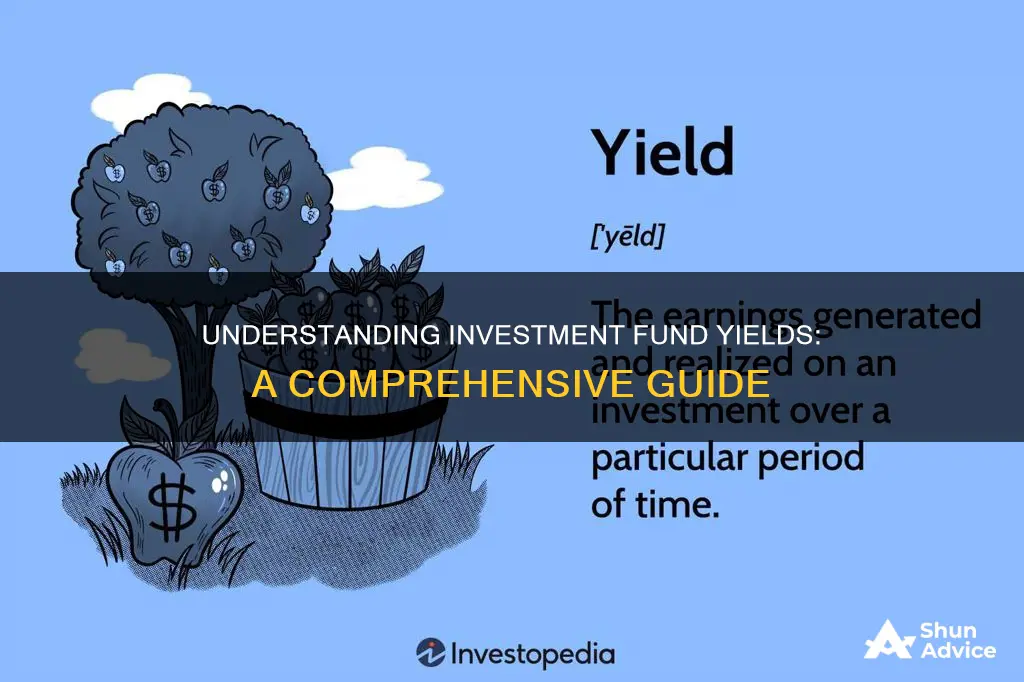
Yield is a crucial metric in finance that measures the return on an investment over a period, typically a year. It indicates how much income an investor or company earns annually relative to the initial cost or market value of the investment. Yield is usually expressed as a percentage of the investment's cost, current market value, or face value. For instance, if a stock with a market value of $50 paid $1.75 in dividends over a year, its annual yield would be 3.5%. Yield is calculated by dividing the income generated by an investment by the investment's price or cost and then multiplying by 100 to express it as a percentage.
| Characteristics | Values |
|---|---|
| Definition | The yield of a stock, bond, or other asset is the earnings generated and realised on an investment over a particular period of time. |
| Calculation | Yield = Net Realized Return / Principal Amount |
| Time Period | Yield is usually computed on an annual basis, although it may be paid quarterly or monthly. |
| Expression | Yield is expressed as a percentage based on the invested amount, the current market value, or the face value of the security. |
| Types | Gross Yield, Net Yield, Yield on Cost (YOC), Current Yield, Nominal Yield, Yield to Maturity (YTM), Yield to Worst (YTW), Yield to Call (YTC), Tax-Equivalent Yield (TEY), Mutual Fund Yield, Stock Yield, Bond Yield, Real Estate Yield |
| Importance | Yield is an important metric in finance because it helps investors make better financial decisions and evaluate whether investing in a company is a good idea. |
| Comparison with Return | Yield and return are both measurements used to express earnings from an investment, but they have distinct features. Yield focuses on income and is forward-looking, while return encompasses total gain or loss and is backward-looking. |
| Risk | A higher yield typically indicates a higher-risk investment. |
What You'll Learn

Yield calculations for stocks
Yield is an important metric in finance because it measures the return on an investment over a period. It tells you how much income an investor or company earns every year relative to the initial cost or market value of its investment.
When it comes to stocks, the yield is the total annual share of a company's profit that is returned to its shareholders in the form of dividends. The yield is usually computed on an annual basis, although it may be paid quarterly or monthly.
The formula for calculating yield for stocks is:
> Stock yield = (dividends per share / stock price) x 100
For example, if a company pays an annual dividend of $7.20 per share and the stock price is $175.50, the stock yield would be:
> Stock yield = ($7.20 / $175.50) x 100 = 4.1%
It's important to note that yield does not include capital gains, only the income generated from dividends.
There are two main types of yield calculations for stocks:
Yield on Cost (YOC) or Cost Yield: This is calculated based on the purchase price of the stock. The formula is:
> Cost Yield = (Price Increase + Dividends Paid) / Purchase Price
Current Yield: This is calculated based on the current market price of the stock. The formula is:
> Current Yield = (Price Increase + Dividend Paid) / Current Price
The choice between using the purchase price or the current price depends on the investor's preference and the specific analysis being conducted.
Dave Ramsey's Mutual Fund Strategies: A Guide
You may want to see also

Yield calculations for bonds
Bonds are loans made by investors to a borrower, usually a company, government, or municipality. They are considered safe investments because their values don't fluctuate as stock prices do. Bondholders receive a fixed form of income, earning interest on the bond throughout its life and receiving the face value of the bond upon maturity.
The yield of a bond is the return an investor realises on their investment. It is usually expressed as an annual percentage rate of return. The yield of a bond can be calculated in several ways, including:
- Coupon yield: This is the annual interest rate established when the bond is issued. This figure remains the same for the lifetime of the bond. The simplest way to calculate the coupon yield is to divide the bond's coupon payment by its face value.
- Current yield: This figure depends on the bond's price and its coupon (its interest payment). So, if the price of the bond changes, the bond's yield also changes. The current yield is calculated by dividing the annual coupon payment by the bond's current market price.
- Yield to maturity (YTM): This is the rate of return expected to be received by a bondholder from the date of original issuance until maturity. YTM is the anticipated annual rate of return earned on a bond, assuming it is held until maturity.
- Yield to call (YTC): This is the return on a callable bond, assuming the bondholder redeemed the bond on the earliest call date before maturity.
- Yield to worst (YTW): This is the minimum return received on a callable bond, i.e. the "floor yield", aside from the yield if the issuer were to default.
The factors that play an integral role in determining the yield on bonds include:
- Face value: The par value of the bond on the date of issuance, which the coupon is based on.
- Coupon rate: The interest rate pricing on the bond, expressed as a percentage.
- Coupon: The annual interest amount owed to the bondholder by the issuer.
- Maturity: The tenor of the bond issuance (i.e. the length of time), as agreed upon by the issuer and the investor in the lending agreement.
College Fund: When to Shift to Safer Investments?
You may want to see also

Yield calculations for mutual funds
Yield is a crucial metric in finance that measures the return on an investment over a period. It is calculated by dividing the income generated by an investment by the investment's price or cost, then multiplying by 100 to express it as a percentage.
Mutual fund yield, also called the distribution yield, is the fund's income return given as a percentage of its market price. It measures the income generated from stock dividends and interest on bonds. The yield is calculated by dividing the annual dividend by the fund's share price. Mutual fund yields are typically calculated daily using the fund's net asset value (NAV), which is determined after the market closes.
> Suppose a mutual fund is $20 per share and paid $0.04 in monthly dividends the past year. The trailing 12-month mutual fund yield is calculated by dividing the annual dividends paid by the share price:
>
> $0.48 ÷ $20 = 0.024, or 2.4%.
However, mutual fund yields can fluctuate due to changes in interest rates, the fund's holdings, and market conditions, which will impact the income distributions to investors.
The S&P 500 Index Fund: Where to Invest Your Money?
You may want to see also

Yield calculations for real estate
Yield is a metric in finance that measures the return on an investment over a period, usually a year. It is calculated by dividing the income generated by an investment by the investment's price or cost, then multiplying by 100 to express it as a percentage.
There are two types of yield calculations for real estate: gross rental yield and net rental yield. Gross rental yield is a simpler metric that does not take into account the property's expenses, while net rental yield does. Net rental yield is generally considered a better metric because expenses do not always scale linearly with income.
- Determine the annual rental income of the property from all tenants.
- Calculate the sum of all fees and expenses incurred from operating the property.
- Subtract the operating expenses from the annual rental income to get the net rental income.
- Divide the net rental income by the property value.
- Multiply the result by 100 to get the yield as a percentage.
For example, let's say a rental property generates $25,000 in rent for the year, and the current market value is $400,000. The operating expenses are $5,000.
The yield for this property would be calculated as follows:
Net rental income = $25,000 (annual rental income) - $5,000 (operating expenses) = $20,000
Yield = ($20,000 net rental income / $400,000 property value) x 100 = 5%
So, the yield for this property investment is 5%.
It is important to note that the yield of a property investment can vary depending on factors such as location, property type, and the current state of the market. A higher yield implies more profits and a better return on investment.
Invest in Nifty Index Fund: Direct Growth Strategy
You may want to see also

How yield differs from total return
Yield and total return are two different ways of measuring the profitability of an investment over a set period of time, often annually. While yield measures the income generated by an investment, total return reflects the overall gain or loss from an investment, including both income and changes in its price.
Yield
Yield is the income returned on an investment, such as the interest from holding a security. It is usually expressed as an annual percentage rate based on the investment's cost, current market value, or face value. For example, if a bond with a face value of $1,000 pays a semiannual coupon of $10, the yield over one year is $20, or 2%. This is known as the cost yield because it is based on the cost or value of the bond.
Yield can be calculated using the following formula:
Yield = (Income / Investment's Price or Cost) x 100
There are two main types of yield: gross yield and net yield. Gross yield does not deduct taxes and expenses, while net yield takes these factors into account.
Total Return
Total return includes interest, capital gains, dividends, and distributions realised over a given period. It reflects the financial gain or loss on an investment and is typically expressed as the change in the dollar value of an investment over time.
For example, if an investor bought a stock for $50 and sold it for $60, the return would be $10. If the company also paid a dividend of $1 during the holding period, the total return would be $11, including the capital gain and dividend.
The formula for calculating total return or rate of return is:
Total Return = (Current Price - Original Price) / Original Price x 100
Key Differences
Yield focuses on the income generated by an investment, typically expressed as a percentage, while total return encompasses the overall gain or loss, including both income and capital appreciation or depreciation, usually expressed as a dollar value. Yield is forward-looking, measuring anticipated income, whereas total return is backward-looking, reflecting the actual financial gain or loss over a specific timeframe.
Index Funds in India: Risky Business
You may want to see also
Frequently asked questions
Yield is a metric in finance that measures the return on an investment over a period, typically a year. It tells you how much income an investor or company earns every year relative to the initial cost or market value of its investment.
Yield is calculated by dividing the income generated by an investment (such as interest from bonds or dividends from stocks) by the investment's price or cost, and then multiplying by 100 to express it as a percentage.
Yield and return are both measurements used to express earnings from an investment, but they have distinct features. Yield is the income returned on an investment, such as interest from holding a security. Return is the financial gain or loss on an investment and is typically expressed as the change in the dollar value of an investment over time.
There are several types of yields, including yields on stocks, bonds, mutual funds, and real estate. For example, yields on stocks refer to the dividends paid per share in a year, while yields on bonds refer to coupon payments, which are paid semi-annually or annually.
A high yield typically indicates that an investment offers a higher income relative to its price. While this can be attractive, it may also signal higher risk, as investors often demand greater compensation for taking on riskier investments.
To calculate the yield of a stock, you can use the following formula: Dividend Yield of a Stock = Total Annual Dividends / Stock Price.







